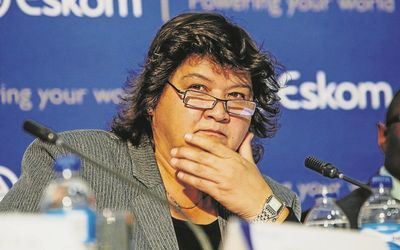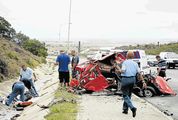STATE-owned freight and logistics company Transnet says it is applying different models to test private-sector participation on branch lines.
The company was speaking to various government departments to enhance the strategy and models to be applied to branch lines, it said.
Branch lines are secondary railway lines running from the main rail line.
Finance Minster Pravin Gordhan said in his budget speech last month that Public Enterprises Minister Lynne Brown was in talks with Transnet leadership to accelerate private-sector participation in the parastatal’s ports and rail projects.
Ms Brown has instructed all state-owned companies under her watch urgently to identify opportunities for public-private partnerships. In the case of Transnet, this included new ports, as well as branch lines, the minister’s spokesman, Colin Cruywagen, said.
Transnet has long mooted the idea of bringing in the private sector to operate its branch lines under concessions. Last year, it made the first call for proposals for one of its branch lines linking Kimberley and De Aar in the Northern Cape.
In 2014, Transnet said private-sector involvement would be sought in running trains on branch lines that would be upgraded at a cost of R200m-R400m a year. About 20 branch lines were identified as possibilities, and a model developed to let private companies use them. The government said it was looking into allowing the private sector to operate on the mainline, and not just branch lines.
Transnet has previously been criticised for not granting concessionaire’s access to the mainline. Critics say branch lines carry little traffic for concessionaires to make them commercially viable. Branch lines need to carry large volumes of freight to be viable.
Goods carried on the branch lines are mainly agricultural products — maize, wheat, barley, malt and sugar cane — as well as commodities such as timber, fuel, chemicals and bulk liquids, according to Transnet. Some of the lines are suited for tourist services.
"So far we have undertaken comprehensive assessments of the business, infrastructure, operations and related investment needs on targeted branch lines," said Transnet spokesman Mboniso Sigonyela.
Prof Jan Havenga, of Stellenbosch University’s Centre for Supply Chain Management, said Transnet should look at accelerating private-sector participation in terminals, dedicated wagons, and branch lines. There had been some successful partnerships around branch lines and wagons.
Prof Havenga said it would not be possible for Transnet to fund everything from its own balance sheet.
"Transnet has done good work in determining long-term rail and port demand for SA and financing expansion to the limit that the balance sheet can accommodate," he said.
Mr Sigonyela said private sector participation was an important part of the company’s funding plan.
Transnet had identified a number of projects in which the private sector could participate. These projects include the Blue Train, for which it has a private-sector marketing partnership with Sun International; the manganese common-user loading facility in the Northern Cape; the Grootvlei loading facility in Mpumalanga; and the Tambo Springs inland container terminal to be built in Gauteng. Also included is a container terminal at the Durban Dig-Out Port — construction of the multi-billion-rand port is yet to begin.
"We view partnerships with the private sector as one of the ways in which we can broaden our sources of funding for capital investments and get access to private sector skills and expertise," Mr Sigonyela said.

Lynne Brown. Picture: SUNDAY TIMES
STATE-owned freight and logistics company Transnet says it is applying different models to test private-sector participation on branch lines.
The company was speaking to various government departments to enhance the strategy and models to be applied to branch lines, it said.
Branch lines are secondary railway lines running from the main rail line.
Finance Minster Pravin Gordhan said in his budget speech last month that Public Enterprises Minister Lynne Brown was in talks with Transnet leadership to accelerate private-sector participation in the parastatal’s ports and rail projects.
Ms Brown has instructed all state-owned companies under her watch urgently to identify opportunities for public-private partnerships. In the case of Transnet, this included new ports, as well as branch lines, the minister’s spokesman, Colin Cruywagen, said.
Transnet has long mooted the idea of bringing in the private sector to operate its branch lines under concessions. Last year, it made the first call for proposals for one of its branch lines linking Kimberley and De Aar in the Northern Cape.
In 2014, Transnet said private-sector involvement would be sought in running trains on branch lines that would be upgraded at a cost of R200m-R400m a year. About 20 branch lines were identified as possibilities, and a model developed to let private companies use them. The government said it was looking into allowing the private sector to operate on the mainline, and not just branch lines.
Transnet has previously been criticised for not granting concessionaire’s access to the mainline. Critics say branch lines carry little traffic for concessionaires to make them commercially viable. Branch lines need to carry large volumes of freight to be viable.
Goods carried on the branch lines are mainly agricultural products — maize, wheat, barley, malt and sugar cane — as well as commodities such as timber, fuel, chemicals and bulk liquids, according to Transnet. Some of the lines are suited for tourist services.
"So far we have undertaken comprehensive assessments of the business, infrastructure, operations and related investment needs on targeted branch lines," said Transnet spokesman Mboniso Sigonyela.
Prof Jan Havenga, of Stellenbosch University’s Centre for Supply Chain Management, said Transnet should look at accelerating private-sector participation in terminals, dedicated wagons, and branch lines. There had been some successful partnerships around branch lines and wagons.
Prof Havenga said it would not be possible for Transnet to fund everything from its own balance sheet.
"Transnet has done good work in determining long-term rail and port demand for SA and financing expansion to the limit that the balance sheet can accommodate," he said.
Mr Sigonyela said private sector participation was an important part of the company’s funding plan.
Transnet had identified a number of projects in which the private sector could participate. These projects include the Blue Train, for which it has a private-sector marketing partnership with Sun International; the manganese common-user loading facility in the Northern Cape; the Grootvlei loading facility in Mpumalanga; and the Tambo Springs inland container terminal to be built in Gauteng. Also included is a container terminal at the Durban Dig-Out Port — construction of the multi-billion-rand port is yet to begin.
"We view partnerships with the private sector as one of the ways in which we can broaden our sources of funding for capital investments and get access to private sector skills and expertise," Mr Sigonyela said.






















Change: 1.37%
Change: 1.32%
Change: 2.91%
Change: 0.45%
Change: 3.09%
Data supplied by Profile Data
Change: 1.59%
Change: 0.47%
Change: 1.37%
Change: 0.00%
Change: 0.44%
Data supplied by Profile Data
Change: -1.57%
Change: -1.54%
Change: -1.15%
Change: -1.27%
Change: -1.14%
Data supplied by Profile Data
Change: -1.48%
Change: -0.62%
Change: -0.98%
Change: -2.26%
Change: -0.36%
Data supplied by Profile Data